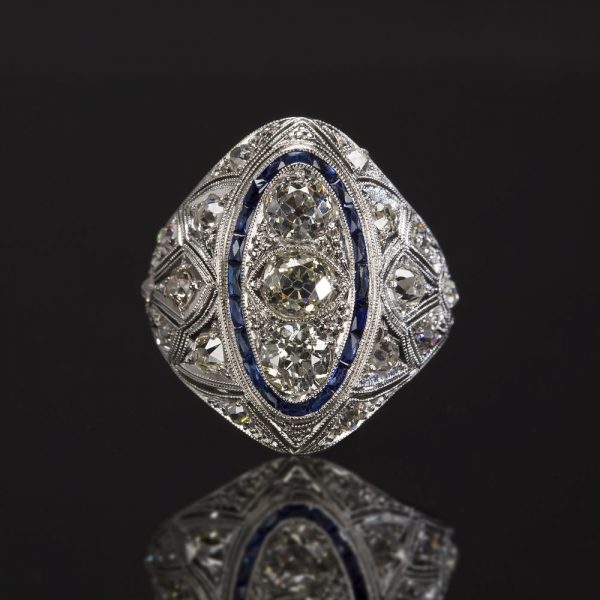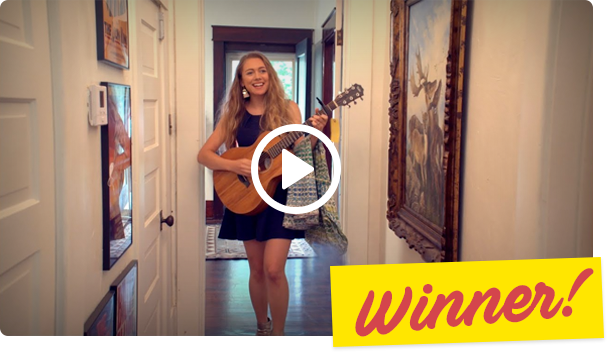Estate jewelry is a loosely used term to identify jewelry from a collection of a deceased, but what it really means is jewelry that’s pre-owned. Whether it’s new, vintage estate jewelry or antique estate jewelry you have, not all estate jewelry pieces are created equal. Here are some tips to help you identify and get the highest value for family heirlooms and jewelry collections.

The Estate Jewelry Obsession
The obsession with jewelry is endless, whether it’s the quality, unique design, historical or resale value, everyone flocks to the jewelry cases at thousands of estate sales across the country on a weekly basis. Don’t believe us? Ask the professionals, we did! We polled our private Facebook group of estate sale companies and auctioneers. Estate jewelry topped the charts along with vintage tools and other collectibles.
We also asked our private group members of estate sale professionals whether it’s best to sell estate jewelry online or on-site at the estate sales:
Joyce Lang with Encore Estate Sales said “We sell fine jewelry at the sale. Individually photographing the pieces and posting with general items advertising the sale. Items are under locked jewelry cases and a staff person is dedicated to showing items to customers. We generally open fine jewelry sales thirty minutes prior to opening the full estate sale. This allows for additional attention and customer service to buyers and added security.”
In the estate sale industry, the majority of family heirlooms and jewelry finds are broken into a few main categories. They’re all considered estate jewelry because they’re pre-owned, but value will differ drastically.
If you’re an estate sale professional, separating the jewelry into categories will ease the process of researching and pricing the many pieces found at the estate sales of avid jewelry collectors.
Estate Costume Jewelry
These may include brooches, necklaces, bracelets, rings, and other jewelry pieces that are made of regular alloy. Some estate sale companies will include the sterling silver jewelry in their estate costume jewelry collection and only consider gold, diamond, and platinum pieces as fine jewelry.

Estate Fine Jewelry
Fine jewelry can include various types of jewelry pieces that have desirable gemstones, are made of gold, platinum, and may include sterling silver pieces also.
Once a collection of jewelry is separated into two main categories, the research begins.
Vintage Estate Jewelry Vs Antique Estate Jewelry
We already know that the word estate is often used to describe pre-owned jewelry items whether it’s fine or costume. For jewelry to be considered antique estate jewelry, it must be 100 years old or older. Vintage estate jewelry may include pieces from the 80’s and 90’s.
Estate Jewelry Guide to Value
The value is determined individually, so don’t automatically discount the value of a jewelry piece simply because it’s not “fine”, silver, gold or platinum. Many vintage brooches, rings, and bracelets are valuable based on the era, style, and designer of the piece.
Look for markings! Certain brands are retired but are still desired by many jewelry collectors. Eisenberg and Weiss are few of the common vintage brooch designers, but even within the brand, certain styles are more desirable than others. Take your time to research and price accordingly in order to get the highest value during an estate sale.
The same applies to fine estate jewelry pieces. Don’t calculate the value of the piece based on the material only. A maker’s mark is extremely important, and if one isn’t available, rely on the style of the piece.
An avid jewelry collector considers estate jewelry finds a form of art. The value in a piece of jewelry is based on how desirable and unique it is, which goes above and beyond the labor and material value of manufacturing it.
Know the Lingo! Styles and Eras of Estate Jewelry
Retro Jewelry
Jewelry from this era were made between 1935 and 1950. The use of gemstones was quite popular along with yellow and rose gold, but not so much platinum. During this period, accessorizing and fashion were very popular. Women began working while men were fighting in WWII. Many jewelry pieces from this era included fur clips, brooches, high collar necklaces, and clip-on earrings started becoming popular.
Art Deco French Inspired Pieces
This Era can be divided into two. One that ran from 1915 to 1929 and the second which ran from 1930 to 1941. The art deco style is extremely desired due to its geometric, sleek design, and modern artistic features which shifted in the second half of the era to a more colorful horizontal design including chunky and bold styles. Platinum and white gold were quite popular during this period, not so much with yellow gold.
Updos were in! This hair style created the perfect frame for dangle earrings, dangle and stacked bracelets, and art deco engagement rings that are still desired by newly engaged couples today.
Edwardian Style Estate Jewels
Pearls, diamonds, and platinum were the popular materials used in Edwardian jewelry of this period which ran between 1900 and 1915. Edwardian jewelry pieces were handmade with masterful craftsmanship and have a very feminine style to them.
The Edwardian era was dubbed “the beautiful era”. If you ever come across a jewelry piece made of platinum and combines diamonds with pearls that drops your jaw at the site of its beauty, you’re more than likely holding an Edwardian estate jewelry piece that’s worth researching further. Look for pretty wreath, garland, and/or floral designs that are set in platinum, a royal look! After all, this period was named after King Edward of England.
Art Nouveau Jewelry Styles
This era ran between 1895 and 1910. There wasn’t a mass production of art nouveau pieces, it was a time of expression with emphasis placed on handmade jewelry masterpieces.
The material used during this period varied and didn’t only include fine gold, platinum, but rather focused on sterling silver and other organic natural materials such as horn, tiger eye, and moonstones.
An art Nouveau piece almost always has flowing curves. As if the form or art of the piece focused on the female curves.
During this period, Art Nouveau hair clips made it to the scene. When you’re going through an antique estate jewelry collection, look for a naturalistic design that involved the use plants, angels, female form, and insects such as dragonflies.
Art Nouveau pieces scream individuality. Since not many pieces were mass produced using machinery, even if it’s not gold or platinum, the value is there due to style’s rarity and demand among avid estate jewelry collectors.
Antique Victorian Jewelry
Romance and sentimental value were important during the Victorian period which ran between 1840 and 1890. The style of jewelry during this period were influenced from England’s queen Victoria. Various materials were used to make jewelry but gold was the preferred material.
The majority of estate Victorian jewelry found will have a monogram because they were considered heirlooms or keepsakes. When a girl wed during this era, she was gifted many monogrammed jewelry pieces that she wore with pride for their sentimental and keepsake value. They were almost always passed on to children and grandchildren.
Gemstones made their way to the forefront during the Victorian era. Amethyst (purple stone) topped the list as the favorite gemstone along with garnet, pearls and citrine set in yellow gold.
Interested in learning more about gemstones? GIA offers an online gemology course to meet your busy schedule.
Solid gold wasn’t the only choice. During this period, gold plating was perfected! So as an estate sale liquidator, keep a close eye on the pieces that have a Victorian style but aren’t necessarily made of fine gold. Even an antique costume estate brooch can have a decent value to a jewelry lover.

Georgian Estate Jewelry Finds
Rare and hard to come by. Named after the four kings of England, king George I, II, IIII, and IV. The Georgian period ran between 1714 and 1835. Elegant in design, thick and heavy. Gemstone such as single cut diamonds, deep blue sapphires, red emeralds, and mostly gold was very common.
It can be difficult to differentiate the Georgian estate jewelry from the Edwardian estate jewelry but keep a closure eye on the metal holding the gemstones. Since it was handmade during this period, the metal holding the stones is much thicker and chunkier than the Edwardian jewelry.
Organizing and Pricing Estate Jewelry
The first and most important step in establishing value is understanding the difference between costume and fine estate jewelry. Once separated, the next step is to try and determine the style. We hope the descriptions above give you a good idea of identifying the style or possibly gives you tips to begin your research.
During the estate sale staging process, it’s best to set the jewelry aside and evaluate it at a later time. Dedicate a time specific to identifying and pricing the jewelry items.
Once you’ve separated your jewelry into two categories, you can further separate it into 5 categories:
- Signed Costume Jewelry
- Unsigned Costume Jewelry
- Signed Fine Jewelry
- Unsigned Fine Jewelry
- Broken, Scrap (Cannot be used as a finished piece of jewelry)
Instead of focusing your efforts on identifying all the jewelry at once, begin researching and pricing each pile at a time and separating them accordingly.

Jewelry Identification Tools You’ll Need
- A Jeweler’s Loop 10x Magnification to see marking closely.
- A magnet to quickly check white metal for any magnetization (sterling silver is not magnetic).
- A precious metal testing kit to identify gold, silver, platinum.
- Diamond tester to check if clear stones are CZ or diamond.
Alaina Loescher with Friendly Estate Sales said “Our company utilizes a jewelry testing kit to determine silver, gold and platinum. We weigh all pieces. If the piece is not branded, we charge based on current metal pricing. Sometimes, if we are unsure about the stones, we will consult an outside specialist. We have noticed that, by selling these items in our sales, we get fair market value for the pieces and the jewelry buyers keep on coming and purchasing other items as well. We get wiped out of fine jewelry every time and the clients are happy to be paid for these items at the same time they receive their check for the rest of the sale items!”
There are hundreds of references online to help you identify maker’s mark and you won’t always be successful in the short period of time you have between setting up a sale and the estate sale opening day, but here are a few tips that will help you.
- Using a jeweler’s loop, look for any markings in and around each piece. Don’t assume that the markings for a ring are always inside the shank. Some very valuable jewelry designers will place the maker’s mark on the outside and only stamp the gold finesse on the inside. A 14k yellow gold band has a huge gap in value if it’s a Cartier 14k Yellow gold band. Keep a close eye and check every inch of the piece.
- Identifying the maker’s mark, try to see it clearly first and search Google using various descriptive keywords. Click on images to try and match the mark you saw to images that might have been placed on the web forums by others looking for a similar maker’s mark.
- Join Facebook Groups dedicated to specific jewelry categories (art deco jewelry, cloisonné jewelry, etc…) Post a picture and ask others to help you identify.
Italian fine jewelry may be marked with the Italian gold designation. Pure gold is 24Kt or .999 fine. It is often found in jewelry from the Middle East, Asia, or India. Here’s a chart that will quickly help you identify markings, the karat and fineness.
| 333 | 8K Gold | 33.3% |
| 375 | 9K Gold | 37.5% |
| 416 or 417 | 10K Gold | 41.6% + |
| 583 or 585 | 14K Gold | 58.3% + |
| 750 | 18K Gold | 75.0% |
| 916 or 917 | 22K Gold | 91.6% + |
| 999 | 24K Gold | 99.9% |
Establishing Estate Jewelry Value
Always remember to never make assumptions. If you’re unsure, place it in an “unsure pile” and dedicate more research time to it later. You don’t want to hinder the efficiency of staging your estate sale, and at the same time, you don’t want to sacrifice a valuable item for a few bucks that might be worth hundreds.
Here’s a quick tip for a situation you may run into sifting through an estate jewelry pile if you’re new to the industry or just started your estate sale company. You come across a vintage estate engagement ring and it is marked 14kp. Many jewelry amateurs would automatically assume the “P” means plated. This assumption couldn’t be farther from the truth.
When you come across a gold piece of estate jewelry marked as 585p or 14kp, the “P” means plumb or in plain English, “exact”. 14kp means the fineness of the gold is exactly 14k gold.
So, you see, it’s important to understand some of the basic markings on jewelry items, which can make a big difference in the overall value and commissions earned by you as an estate sale professional.
Another very common assumption made on sterling silver jewelry is:
“If it’s silver, the clear stones set in a vintage ring or antique pendant must be Cubic Zirconia”.
Put your diamond tester to work here, because since the gold prices have skyrocketed, many jewelry makers began setting diamonds in sterling silver jewelry. What you may assume to be a $20 to $40 ring, may actually be worth $100 to $150. That’s double and triple the value.
Popular Vintage Estate Jewelry Categories
Value is important and, in some ways it is directly related to what people favor. Here are a few of the most sought-after jewelry items by shoppers.
Designer Jewelry Pieces
Any designer signed jewelry piece, both costume and fine estate jewelry (Tiffany & Co., Cartier, Eisenberg, Weiss, are just a few of the most common ones).
Vintage Costume Brooches
Brooches have made a comeback and there are so many uses for them. They hit the fashion runways in Paris and New York a few years back and have continued to grow in popularity. Many shoppers use them in crafts or repurpose them as bling to accessorize hats, scarves, and even updo hair styles.
Even an unsigned costume brooch can fetch a decent price if it’s unique in shape and style. When it comes to costume brooches, “the bigger, the better”.
Estate Antique Engagement Rings
Not sure what the attraction is, but I think it’s the unique designs, quality craftsmanship and the mysterious history behind the vintage engagement rings and antique wedding rings that come from a time and place unknown.
Many new couples look for true vintage and antique engagement rings and wedding bands. Although new designers are trying to mimic the original styles, new couples prefer the original and historical value of a true vintage or antique engagement ring.
Native American Indian Jewelry
Highly desired by avid collectors. Some signed vintage estate jewelry pieces by particular artisans can fetch a hefty price. When pricing native American Indian jewelry, don’t focus on the material only but rather the signature and research who the artisan is. The native American Indian Jewelry commands an article in itself. Here is a great reference to use for American Indian artisan identification purposes.
EstateSales.org is your online resource destination for all things estate sales. We offer a robust website that allows you to advertise your estate sale company and generate leads, list your estate sale to reach buyers and an online timed estate auction marketplace that reaches avid collectors worldwide.
Our team is dedicated to you and your business. If there’s a topic you’d like us to research and document, feel free to comment below or send us a message.




